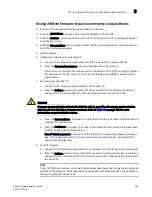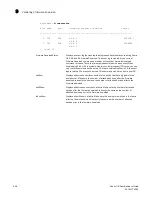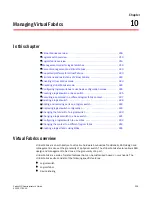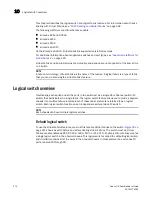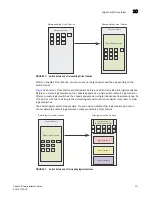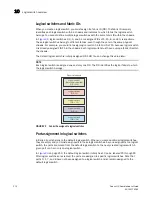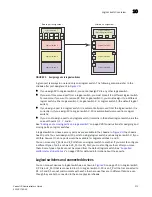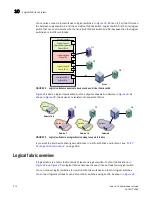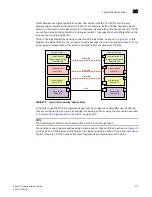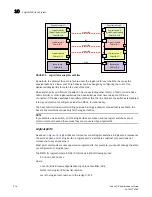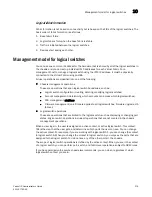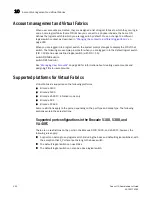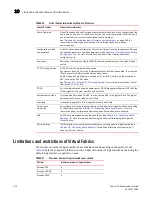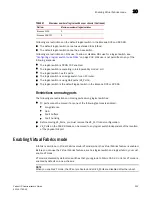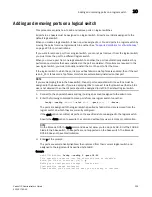
216
Fabric OS Administrator’s Guide
53-1001763-02
Logical fabric overview
10
NOTE
Only logical switches with the same FID can form a fabric. If you connect two logical switches with
different FIDs, the link between the switches segments.
Logical fabric and ISL sharing
Another way to connect logical switches is using extended ISLs and base switches.
When you divide a chassis into logical switches, you can designate one of the switches to be a base
switch. A
base switch
is a special logical switch that is used for interconnecting the physical
chassis. A base switch has the following properties:
•
ISLs connected through the base switch can be used for communication among the other
logical switches.
•
Base switches do not support direct device connectivity. A base switch can have only E_Ports,
VE_Ports, EX_Ports, or VEX_Ports, but no F_Ports.
•
The base switch provides a common address space for communication between different
logical fabrics.
•
A base switch can be configured for the preferred domain ID just like a non-Virtual Fabrics
switch.
•
You can have only one base switch in a physical chassis.
A base switch can be connected to other base switches through a special ISL, called a
shared ISL
or
extended ISL
(XISL). An extended ISL is an ISL that connects base switches. The XISL is used to
share traffic among different logical fabrics.
Fabric formation across an XISL is based on the FIDs of the logical switches.
Figure 28
shows two physical chassis divided into logical switches. Each chassis has one base
switch. An ISL connects the two base switches. This ISL is an extended ISL (XISL) because it
connects base switches.
FIGURE 28
Base switches connected by an XISL
Base switch
Fabric ID 8
P9
Logical switch 7
Fabric ID 15
P7
Logical switch 6
Fabric ID 1
P4
Logical switch 5
(Default logical switch)
Fabric ID 128
Physical chassis 2
Base switch
Fabric ID 8
P6
Logical switch 3
Fabric ID 15
P5
Logical switch 2
Fabric ID 1
P2
Logical switch 1
(Default logical switch)
Fabric ID 128
P1
Physical chassis 1
P8
P6
P2
P1
XISL
Summary of Contents for 53-1001763-02
Page 1: ...53 1001763 02 13 September 2010 Fabric OS Administrator s Guide Supporting Fabric OS v6 4 0 ...
Page 4: ...iv Fabric OS Administrator s Guide 53 1001763 02 ...
Page 24: ...xxiv Fabric OS Administrator s Guide 53 1001763 02 ...
Page 28: ...xxviii Fabric OS Administrator s Guide 53 1001763 02 ...
Page 32: ...xxxii Fabric OS Administrator s Guide 53 1001763 02 ...
Page 40: ...xl Fabric OS Administrator s Guide 53 1001763 02 ...
Page 42: ...2 Fabric OS Administrator s Guide 53 1001763 02 ...
Page 54: ...14 Fabric OS Administrator s Guide 53 1001763 02 High availability of daemon processes 1 ...
Page 74: ...34 Fabric OS Administrator s Guide 53 1001763 02 Basic connections 2 ...
Page 102: ...62 Fabric OS Administrator s Guide 53 1001763 02 Audit log configuration 3 ...
Page 214: ...174 Fabric OS Administrator s Guide 53 1001763 02 Management interface security 7 ...
Page 228: ...188 Fabric OS Administrator s Guide 53 1001763 02 Brocade configuration form 8 ...
Page 276: ...236 Fabric OS Administrator s Guide 53 1001763 02 Creating a logical fabric using XISLs 10 ...
Page 404: ...364 Fabric OS Administrator s Guide 53 1001763 02 ...
Page 440: ...400 Fabric OS Administrator s Guide 53 1001763 02 Performance data collection 17 ...
Page 480: ...440 Fabric OS Administrator s Guide 53 1001763 02 F_Port masterless trunking 19 ...
Page 494: ...454 Fabric OS Administrator s Guide 53 1001763 02 Buffer credit recovery 20 ...
Page 574: ...534 Fabric OS Administrator s Guide 53 1001763 02 Hexadecimal overview E ...




